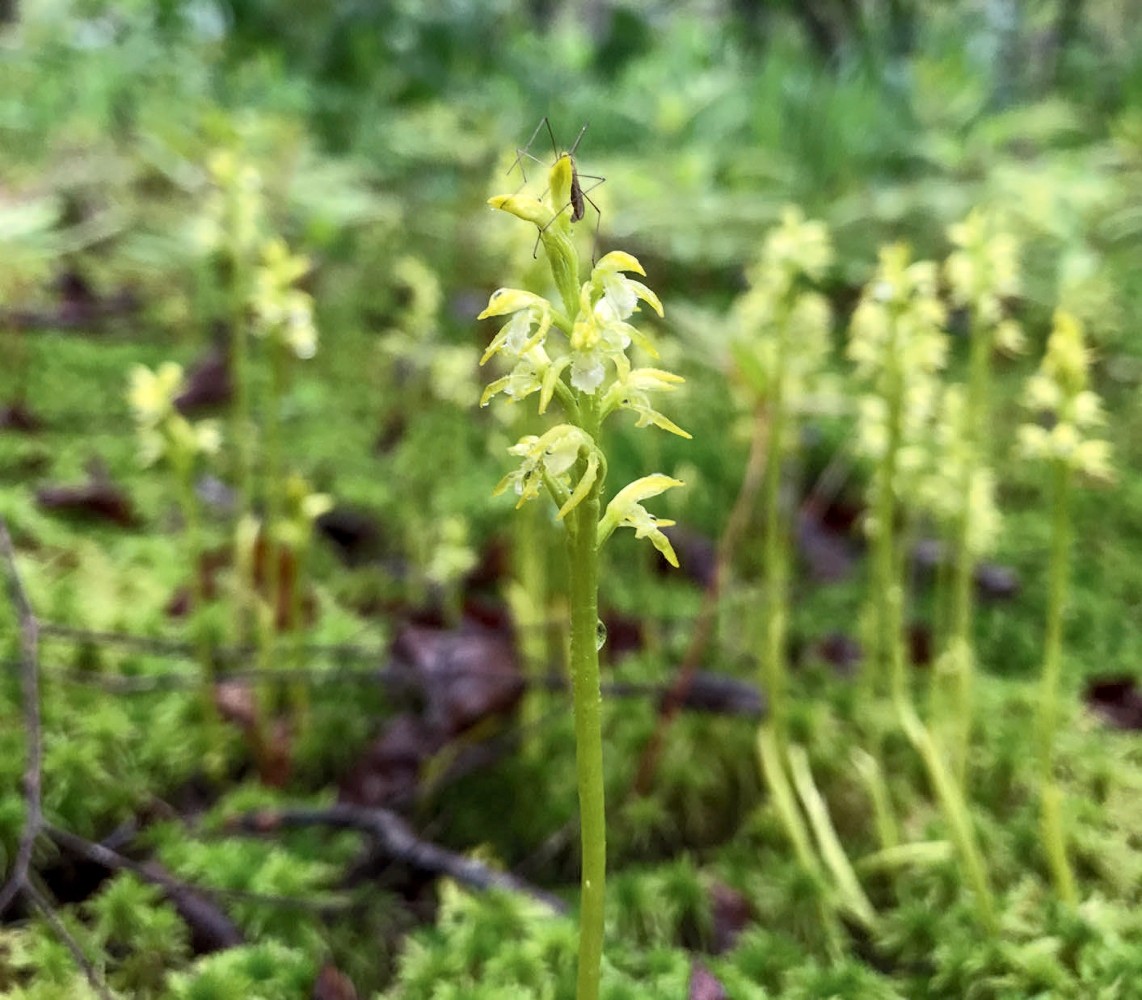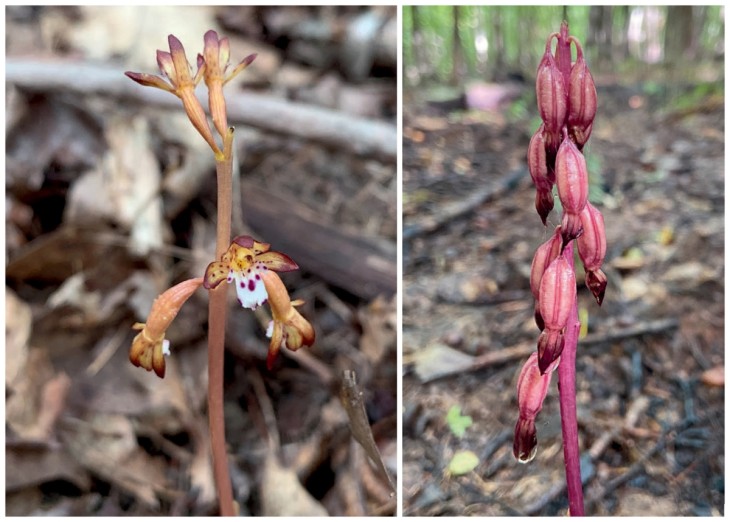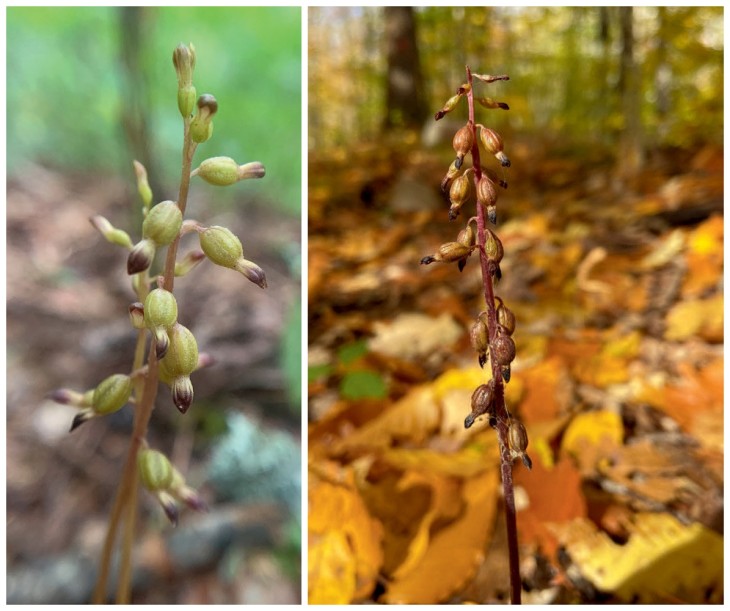
Deer browse is a major factor contributing to the decline of many native orchids. The showy and charismatic species are most severely affected, drawing not only our gazes but also the attention of hungry ungulates. One strategy for a plant to avoid herbivores is to blend in with its surroundings. Exemplifying this strategy are the coral-roots, in the genus Corallorhiza (literally “coral-root”), whose cryptic coloration and small stature help them avoid detection. This means they are easy to miss by us humans as well, so it helps to study up on their traits.
These plants are named for their coral-like “roots,” which are technically rhizomes. These stocky, branched structures store carbohydrates to fuel flowering and fruiting. But these root systems do not act alone. Like all our native orchids, coral-roots are mycoheterotrophic: they have an obligate relationship with a fungal host that provides a portion of the plant’s nutrients and carbohydrates. Coral-roots are known to associate with ectomycorrhizal fungi in the family Russulaceae, a large family of forest mushrooms. Because the aboveground plants are small, nearly leafless, and have little to no chlorophyll, coral-roots rely heavily – often entirely – on their host fungus to obtain nutrients. The relationship is one-sided, as the orchids don’t provide any benefit to the fungi. In fact, coral-roots are considered parasitic on their host fungus.
In the Northeast, there are three widespread coral-roots that span the growing season. (A fourth species, the striped coral-root, Corallorhiza striata, is found around the Great Lakes, but it is absent from greater New England.) Each of these species can seemingly disappear among the moss or leaf litter. And, because they are strongly mycoheterotrophic, they can lie dormant in the soil for many years, making them even more difficult to detect. In some years, however, an unknown combination of environmental cues seems to call the coral-roots out of dormancy. In such years, we may notice coral-roots blooming more abundantly and in places we haven’t seen them before. In this way, coral-roots teach us to “expect the unexpected,” and it is our task to be ready to notice them when they appear.
Early Coral-root, Corallorhiza trifida
This is the greenest of the coral-roots. I usually find it in dark conifer swamps of spruce and hemlock, nestled in cushions of Sphagnum moss. These habitats are naturally cool, wet, and often acidic. The plants take on many shades of light green, sometimes nearly yellow. Flowers are small and yellow-green, except for the labellum (lip), which can be bright white without any markings. Stems often arise in dense clusters emanating from different parts of a large, shared rhizome, which can help to locate populations.
This is among the earliest orchids to bloom. In the Berkshire highlands of western Massachusetts, I find it flowering mostly during the latter half of May. In more northern latitudes or at higher elevations, it may be a few weeks into June before this species begins to appear. Pollinated flowers form elliptical capsules that hang pendant-like along the stem. Fruiting plants retain their bright yellow-green coloration throughout summer.
Spotted Coral-root, Corallorhiza maculate
Spotted coral-root is the most common species in the region, occurring in dry to damp hardwood or mixed-wood forests. It is named for the striking purple spots on the white labellum of each flower. Plants lack chlorophyll entirely and are usually orange or yellowish brown, blending in with the leaf litter. They may also be reddish to purple (like their spots). Stems are more stout than in other species and appear singly or a few together (not in dense clusters). At about ½ inch wide, spotted coral-root flowers are also the largest of the three species.
The habitat of spotted coral-root is rather nondescript, with common trees in the overstory and very little ground cover. Yet, it can still be difficult to pick out against the mottled leaf litter. This is a summer species, appearing in mid-July and flowering into August. Fruits are elliptical capsules, more than ½ inch long, of similar color to the stems. Dried flower remnants stay attached to the capsule, even through winter.
Autumn Coral-root, Corallorhiza odontorhiza
The common name of this species is somewhat of a misnomer. Flowering begins in the latter half of August and continues through September – still mostly summer, by the calendar. But this timing is much later than most orchids, and, indeed, this species is the latest-flowering coral-root. It grows throughout New England, across to the Lakes States, and in adjacent Canadian provinces. More common to our south, it is rare in many of our northern localities. Its typical habitat is hardwood forest on loamy soil.
This is a cryptic species, most similar to spotted coral-root, but smaller in all respects. Stems are usually purplish brown or gray-brown, often solitary, but sometimes arising in dense clusters. Flowers are small (about ¼ inch), and they most often remain closed (they are self-fertilizing, or “cleistogamous”). Plants with open-pollinated flowers (sometimes considered a distinct variety) have a purple-spotted, white labellum similar to the spotted coral-root. Capsules are very small, up to 5/16 inch in length, elliptical to nearly spherical. Many autumn coral-root plants have trace amounts of chlorophyll, so detecting a blush of green is not out of the question, especially in the ripening capsules.




